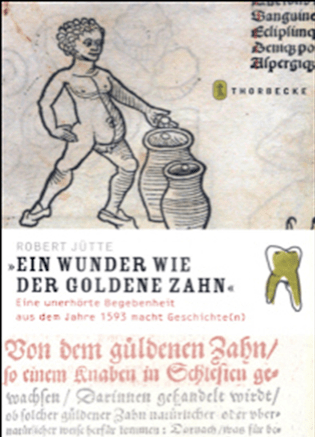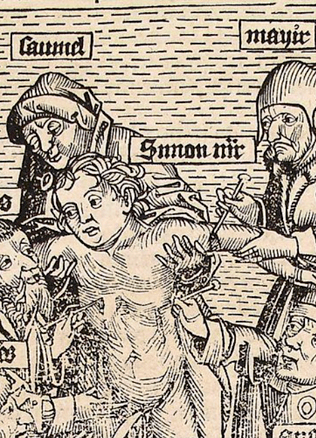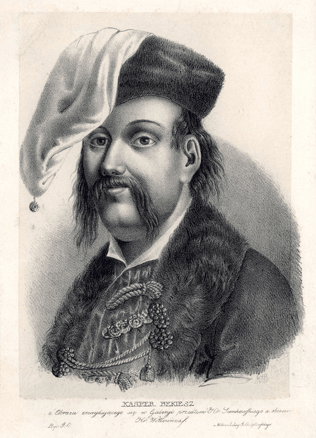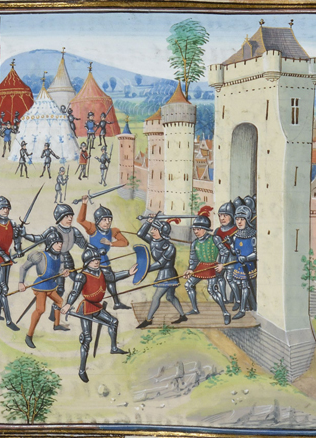The Myth of Navahrudak
The prospering Navahrudak of the 12th and early 13th century became the most important agricultural and commercial centre of the Upper Nemunas region, joining Southern Lithuania, the northern and eastern Yotvingians and southwestern Rus’ lands. The city did not lack for luxurious items and imported goods. For example, there was coloured glass made in the Byzantine Empire, Syria and Egypt, gilded dishes, wine and olive oil brought in amphorae made in workshops from the northern shores of the Black Sea (one of the most plentiful artefacts in the cities of the Kievan Rus’), luxurious Iranian tin-glazed earthenware ceramic items, silk cloth and chests decorated with engraved bone panels from Byzantium, jewellery, slate spindles, window glass from Kiev, glass dishes from workshops in Silesia and the shores of the Rhein, products made from coloured and precious metals and metal material from Central and Northern Europe, raw amber and weapons from the lands of the Balts. Wealthy artisans and merchants lived in the city, and some houses had windows fitted with glass, while the walls were decorated with frescos. A quarter of goldsmiths and jewellers that had achieved a high level of mastery formed at the base of the castle. Just a few of the cities of the ancient Rus’ could boast of such luxury and expanded international trade ties.
Do You Know?
Navahrudak, which prospered in the 12th and beginning of the 13th century, was famous for its luxurious items and imported goods. For example, there was coloured glass made in the Byzantine Empire, Syria and Egypt, gilded dishes, wine and olive oil brought in amphorae made in workshops from the northern shores of the Black Sea, luxurious Iranian tin-glazed earthenware ceramic items, silk cloth and chests decorated with engraved bone panels from Byzantium. The homes of the wealthiest merchants had windows encased with glass, while the walls were decorated with frescos. Unfortunately, after the Lithuanians invaded, the city, which was destroyed by war, had turned into a shadow of its former luxuriousness.
The end of a golden age
The prosperity of Navahrudak was heavily influenced by its ideal geographical and strategic location. The Russian cities of the Upper Nemunas and its left tributaries appeared during the times of the prospering of the Kievan Rus’ and depended on the Kievan duke and the city’s economy, because they were the consumers of its products and mediators of trade with the Balts. The cities that were the military and political pillars of the Rus’ that were founded in the mixed Lithuanian and Yotvingian border areas turned into bases for the colonization and military expansion – the convenient commercial and geographical location and receptive pagan market turned them (especially Navahrudak) into prosperous artisan and trade centres. The former lands that were under the control of the cities did not end up in the system of possessions (appanages) of the Ruthenian dukes, which is why integral political structures did not form, such as duchies and dynasties of local dukes. With the weakening of Kiev at the turn of the 13th century, these cities were politically influenced by the Kingdom of Halych–Volhynia.
Navahrudak, the centre of an active international trade crossroads, attracted the political rule of Lithuania. Mindaugas occupied the entire region in the 1340s, and turned Navahrudak into its de facto centre.
In the second half of the 13th century, Navahrudak was decimated by bloody wars between Lithuania, Galicia-Volhynia and the Tatars.
The weakening Rus’ had no plans to give up their important commercial and strategic centre so easily, but were unable to keep up the pressure. However, what remained of these prosperous cities of the region at the end of the 13th century for the Lithuanians was only a shadow of what once was – the city of Navahrudak, except for the castle, was turned into a pile of burning embers by attacks from the dukes of Galicia-Volhynia, who were supported by the Tatars. However, before these events, the flood of Tatars in the lands of the Rus’ put an end to the traditional trade of the river region of the Black Sea, Dnieper, Bug, and Vistula rivers for a long time.
The Lithuanian period
The economy of Navahrudak that belonged to Lithuania was revived around in the 1410s. At the beginning of the 14th century, Vytenis built a church for the Franciscans in Navahrudak. After being destroyed by the Teutonic Knights, it was rebuilt by Gediminas. The church was not for the Christianisation of the pagans, but for the needs of the Catholic merchants that had settled there. In the 1420s Gediminas planned on settling Western colonists in Navahrudak (as well as in Vilnius). The prosperity of Navahrudak was confirmed by the founding of the centre of Lithuania’s Orthodox metropolitan there. The income from trade had to support its vitality.
Navahrudak became a kind of arena for synthesizing processes and the creation of a civilisation of the Grand Duchy of Lithuania, in which the Lithuanians transformed the innovative Rus’ model.
In the times of Vytenis and Gediminas, a Catholic church was built, the a Lithuanian Orthodox Metropolitanate was founded in 1315-1317 (which existed until 1330), with pagan Lithuanian settlements nearby. Navahrudak as a duchy was ruled by Gediminas’ son Karijotas and his descendants, who were already Orthodox, started in 1329. When Lithuania seized Volhynia and its important trade routes in the middle of the 14th century, the role of Navahrudak in commerce weakened, because the importance of the cities on the trade route along the River Bug grew. However, Navahrudak remained the military and strategic centre of the state. The settlements that belonged to it were attacked by the Teutonic Knights at the end of the 14th century. This is why a brick fortification was built on Pilies Hill at the turn of the 15th century.
Navahrudak – the capital of Lithuania?
The pillar of the political and commercial network of Mindaugas, the first Lithuanian monarch, was enmeshed in the land of Lithuania between the Neris and the Upper Nemunas, just as it had been for his father and his entire family. Being neighbours with ethnically mixed border territories that were dominated by agricultural and trade centres founded and inhabited by Russians (Navahrudak, Grodno, Slonim and Volkovysk) was an influential factor in their early falling under Lithuanian control. It is thought that Vaišelga Mindaugaitis was chosen as Mindaugas’ vicegerent in Navahrudak. There were no plans for this occupied city to take on the role as the Lithuanian capital.
The idea that Navahrudak became Mindaugas’ capital is a myth created by the Bychowiec Chronicle in the first half of the 16th century.
It was expanded upon by Maciej Stryjkowski in his Chronicle of Poland, Lithuania, Samogitia and all of Ruthenia (1582).
Currently this myth is parasitic in Belarusian historiography. Its supporters emphasize the influential role of Navahrudak (the role of the Russian nobility, merchants and artisans) in the creation of the Lithuanian state. They argue that the city stood in a contact zone between Balts and Slavs, and that a new ethnic community appeared here in the 13th century-Belarusians, with the entire region taking on the name Litva (Lithuania). Navahrudak remained the centre of this region, the borders of which stretched to Minsk and Vilnius. In 1248 the Eastern Slav city of Navahrudak created a union with Mindaugas, a newcomer to Baltic nobility, and created the first Belarusian state. Lithuanian historiography denies these allegedly scientific theories with reasoned arguments.
Literature: Lietuvos istorija, t. 3, XIII a. – 1385 m.: Valstybės iškilimas tarp Rytų ir Vakarų. D. Baronas, A. Dubonis, R. Petrauskas. Vilnius, 2011.
Artūras Dubonis



